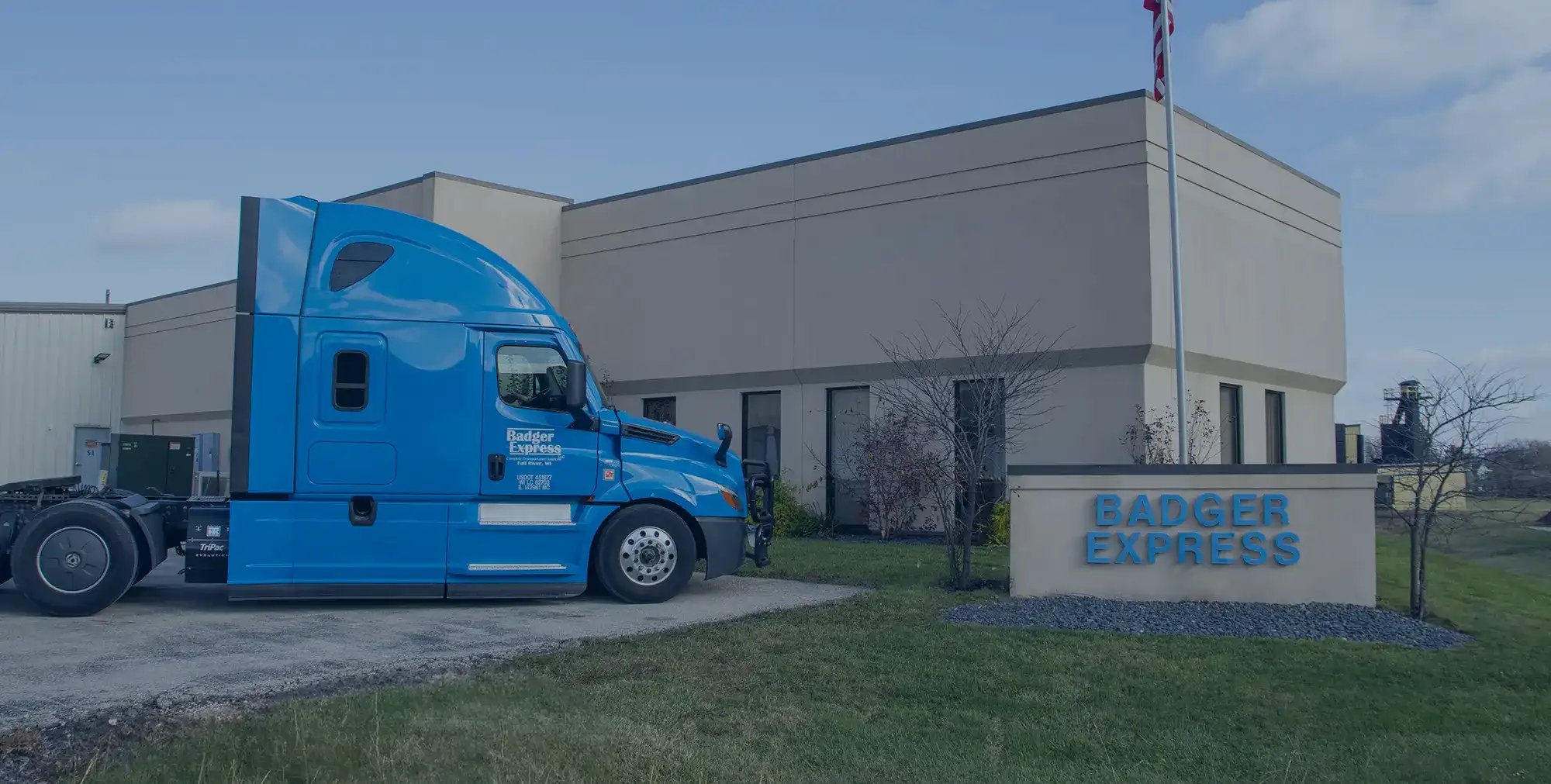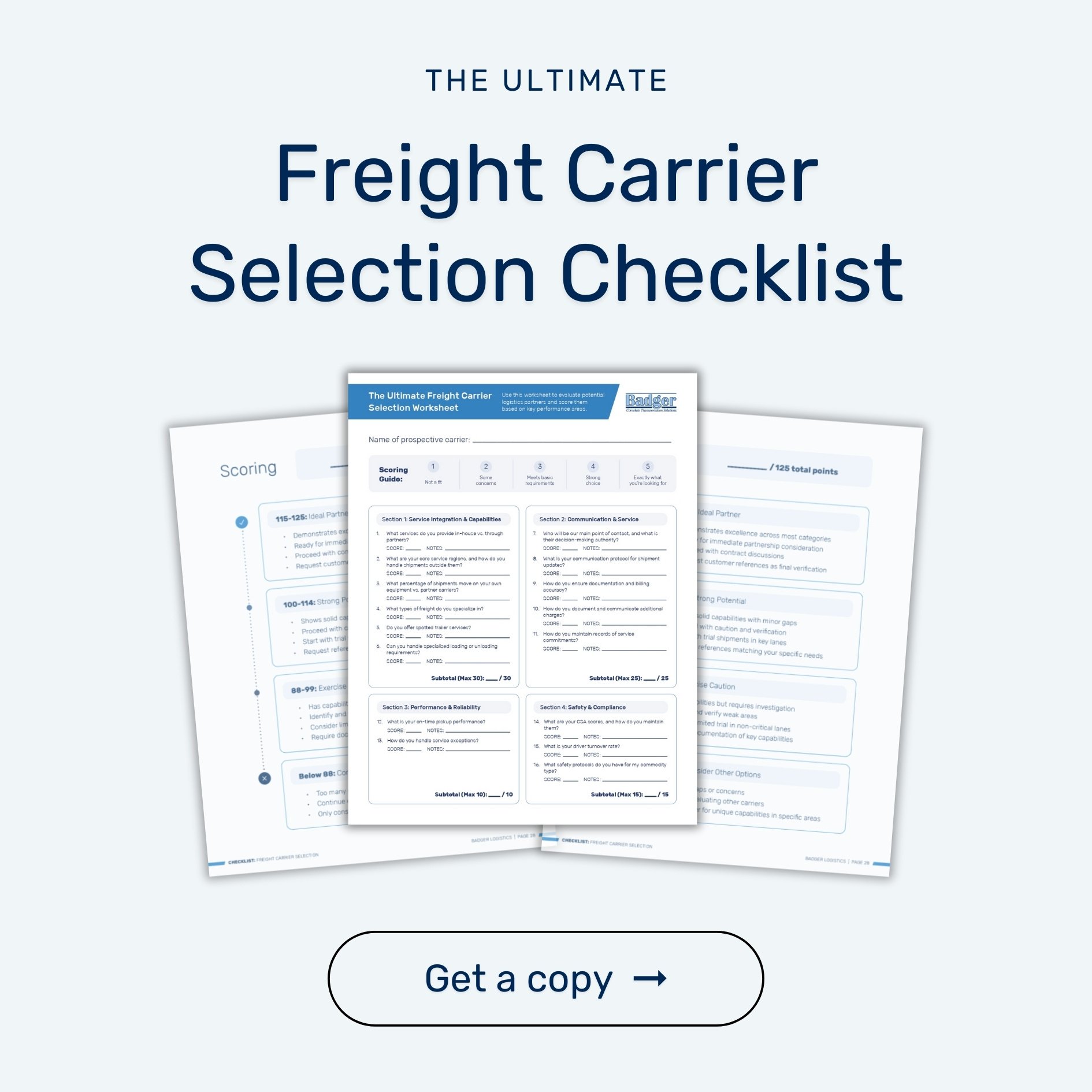Key takeaways
- Freight pricing is dynamic and multifaceted. Rates fluctuate based on geography, equipment type, market conditions, and shipment specifics. Understanding these factors helps shippers navigate pricing volatility and make cost-effective decisions.
- Contract vs. spot rates require strategic use. Contract rates offer stability for consistent lanes, while spot rates allow flexibility in fluctuating markets. A blended approach helps balance cost savings and service reliability.
- Shipper reputation and operational efficiency affect costs. Carriers consider factors like payment history, loading/unloading efficiency, and volume consistency when pricing freight. Being a "shipper of choice" can lead to better rates and service.
Badger Logistics provides integrated transportation solutions combining asset-based trucking, brokerage services, and warehousing to overcome Wisconsin's unique logistics challenges. Learn more about our Wisconsin shipping expertise or get a competitive rate quote to join 500+ shippers solving their freight challenges with one call.
A brief introduction
In my 15+ years in the logistics industry, one question consistently comes up when talking with shippers: "How exactly are freight rates determined?" The confusion is understandable.
Freight pricing can seem like a mysterious black box, especially when rates fluctuate dramatically from one week to the next or when two seemingly similar shipments receive vastly different quotes.
Today, I want to pull back the curtain on freight pricing. I've seen pricing from both the asset-based carrier and brokerage perspectives. Understanding these dynamics doesn't just satisfy curiosity—it helps you become a more informed shipper and potentially save significant transportation dollars.
The fundamentals of freight pricing in 2025
Freight rates are determined by a complex interplay of factors, many of which aren't immediately obvious. Let's break down the most influential components:
Distance and geography
While distance is an obvious factor, the relationship between miles and price isn't as straightforward as you might think:
- Short-haul vs. long-haul economics: For shorter runs (typically under 250 miles), carriers often charge higher per-mile rates. Why? Because drivers are still putting in significant work time for loading, unloading, and dealing with traffic, regardless of distance traveled. On these shorter hauls, drivers think about how much of their day a load will consume rather than just the mileage.
- Regional differences: Some markets consistently command higher rates due to imbalanced freight flows. For instance, areas with heavy manufacturing output but low inbound freight will typically have higher outbound rates because carriers need to factor in the cost of potentially returning with empty trailers.
Equipment type
Different equipment types come with different cost structures and market dynamics:
- Dry van: The most common trailer type with the largest carrier base, dry vans typically have the most competitive rates due to widespread availability.
- Reefer (refrigerated): Reefer rates run higher than dry van rates because of the specialized equipment, additional fuel for temperature control, and more limited carrier availability. Maximum weight is typically around 43,500 pounds compared to 45,000 pounds for dry vans due to the weight of the refrigeration unit.
- Flatbed: Rates for flatbed equipment fluctuate significantly by season and region. Additional considerations like tarping, securing loads, and specialized handling all factor into pricing. The variety of flatbed equipment (standard flatbeds, step decks, RGNs, etc.) further complicates pricing.
- Intermodal: Rail-based intermodal shipping typically offers cost savings for longer hauls (700+ miles) but comes with longer transit times and less flexibility.
Market conditions
This is where freight pricing gets truly dynamic.
- Capacity vs. demand: When carrier capacity is tight compared to shipping demand, rates increase. During economic booms or seasonal peaks, you'll see rates climb. Conversely, in softer markets with excess capacity, rates tend to fall.
- Fuel costs: Fuel represents a significant portion of carrier operating costs. While many carriers build fuel surcharges into their rates, rapid increases in fuel prices can still drive up overall rates.
- Seasonal factors: Certain times of year predictably affect rates. Produce season in summer can draw refrigerated capacity away from other goods. The pre-holiday shipping rush typically tightens capacity across the board.
Shipment specifics
Your particular freight's characteristics significantly impact pricing:
- Weight and density: Heavier shipments increase fuel consumption and wear on equipment. However, very light but bulky items that "cube out" a trailer before reaching weight limits can also command premium rates because they use the full capacity without maximizing payload.
- Handling requirements: Special requirements like liftgates, inside delivery, limited access locations, or driver assistance all add costs.
- Appointment windows: Strict delivery appointments, especially during peak hours, can increase rates as they limit carrier flexibility.
- Detention risk: Locations known for long loading/unloading times will see rate premiums as carriers factor in potential detention time.
Contract rates vs. spot rates
It's crucial to understand the fundamental difference between contract and spot rates:
|
Contract rates are negotiated for consistent, scheduled freight moved over extended periods (typically 6-12 months). They provide pricing stability but may be higher or lower than current market rates depending on market conditions when they were negotiated. Spot rates are one-time quotes for immediate shipping needs based on current market conditions. They tend to be more volatile but may be lower in soft markets or higher during capacity crunches. |
At Badger Logistics, we work with both models depending on our customers' needs. For many of our Wisconsin-based manufacturers with consistent shipping patterns, we establish contract rates that provide stability and predictability. For others with more variable needs, our extensive carrier network allows us to secure competitive spot rates across all equipment types.
The asset-based vs. brokerage pricing dynamic
Understanding the difference between asset-based carriers and brokers is essential to understanding pricing.
|
Asset-based carriers (like Badger Express, our trucking division) have fixed costs—equipment payments, driver salaries, maintenance, insurance, etc. Their rates must cover these overhead expenses regardless of market conditions, though they do fluctuate somewhat with the market. Brokers (like Fall River Express, our brokerage division) are more directly tied to market rates since they're securing capacity from a network of carriers whose pricing reflects current conditions. In soft markets, brokerage rates can drop significantly, while in tight markets, they may increase more dramatically than asset rates. |
This is precisely why we maintain both divisions at Badger Logistics.
- When market rates are low, our brokerage can often secure very competitive rates.
- When capacity tightens and market rates spike, our asset-based fleet provides reliable capacity at more stable pricing.
This integrated approach gives our customers options regardless of market conditions.
The hidden factors that can impact your rates
Beyond the obvious factors, several less apparent elements influence what you pay:
A carrier's experience with your lanes
Carriers develop expertise and efficiency on lanes they run regularly. If you're shipping on a lane where a carrier already has regular volume, you might secure better rates because:
- They're familiar with the facilities and procedures
- They may have established backhauls in the area
- They can plan driver schedules more efficiently
This is why working with providers who have strong regional knowledge (like our team's decades of experience in Wisconsin and the Midwest) often results in better rates and service.
Freight attributes beyond size and weight
Carriers consider other factors when pricing:
- Value of goods: High-value shipments may require additional insurance or security measures.
- Hazardous materials: These require special handling, training, and insurance.
- Handling sensitivity: Freight that requires careful handling may command premium rates.
Your reputation as a shipper
This might surprise you, but how carriers and brokers perceive your operation affects your rates:
- Loading/unloading efficiency: Facilities known for quick turnarounds often receive better rates.
- Payment terms and history: Faster payment terms can sometimes secure better rates.
- Volume and consistency: Regular, predictable volume is valuable to carriers and can translate to better pricing.
At Badger, we've built strong relationships with both shippers and carriers by understanding and respecting these dynamics. We know which carriers prefer which lanes and facilities, allowing us to match the right carrier to each load for optimal pricing and service.
Practical tips for managing your freight costs
Based on my experience working with hundreds of shippers across Wisconsin and beyond, here are some actionable strategies for managing your freight spend:
1. Understand your specific freight profileTake time to analyze your shipping patterns:
This information is crucial for developing an effective strategy. When customers share this data with us, we can help identify opportunities for consolidation, mode optimization, and better carrier matching. |
2. Be flexible where possibleSmall adjustments can yield significant savings:
I've seen customers save 10-15% simply by adjusting appointment times to avoid peak hours or allowing morning pickups for next-day delivery instead of same-day service. |
2. Be flexible where possibleSmall adjustments can yield significant savings:
I've seen customers save 10-15% simply by adjusting appointment times to avoid peak hours or allowing morning pickups for next-day delivery instead of same-day service. |
3. Consolidate when it makes senseCombining smaller shipments into fuller loads often reduces overall costs:
Our 210,000-square-foot warehouse in Fall River helps many customers consolidate shipments and build more efficient loads, significantly reducing their per-unit shipping costs. |
4. Build strong carrier relationshipsWhether you're working directly with carriers or through a broker:
The best rates often come from established relationships rather than transactional, one-off moves. This relationship approach is central to how we operate at Badger. |
5. Use a mix of contract and spot marketA blended approach often yields the best results:
This balanced strategy is exactly why we maintain both asset-based and brokerage capabilities—it gives our customers the flexibility to use whichever option makes the most economic sense at any given time. |
The bottomline: transparency leads to better partnerships
Understanding freight pricing isn't just about negotiating better rates—it's about creating realistic expectations and building stronger logistics partnerships. When shippers understand the factors driving rates, they can make more informed decisions about their supply chain strategies.
The most successful shipping relationships I've seen over my 15+ years in this industry aren't those where either the shipper or carrier is constantly squeezing the other for every penny. Rather, they're partnerships built on mutual understanding, fair pricing that allows for quality service, and respect for each party's business needs.
At Badger Logistics, we believe transparency is the foundation of trust. Whether you're working with our asset-based fleet, our brokerage division, or our warehousing services, we're committed to helping you understand not just what your rates are, but why they are what they are—and how we can work together to optimize your shipping strategy.
Talk to us for a better Wisconsin logistics experience

At Badger Logistics, we combine asset-based trucking with extensive brokerage capabilities, warehousing, and maintenance services to provide integrated logistics solutions for Wisconsin shippers. This guide reflects not just my personal experience but the collective wisdom of our team, which brings over a century of combined Wisconsin logistics experience to every shipment we handle.
While freight transportation will always involve challenges, the right approach and partnerships can transform logistics from a constant struggle into a sustainable competitive advantage. I hope this guide helps you navigate Wisconsin's unique shipping environment more effectively.
For specific questions or to discuss your particular freight challenges or to get a competitive quote, feel free to reach out directly or submit the quote request form below. We'll be in touch within one business day.





